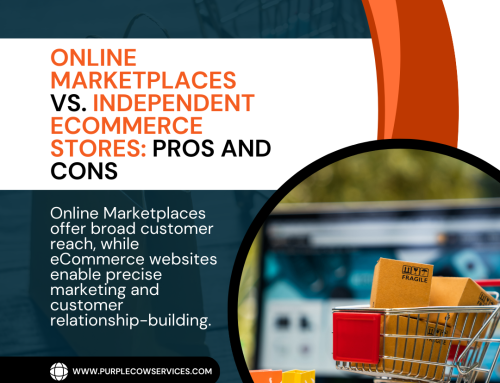Consumer behavior analysis is the process of studying how individuals make purchasing decisions and interact with products and services.
Share This Story, Choose Your Platform!
It goes beyond just tracking website visits and click-through rates; it’s about uncovering the “why” behind every action. This powerful tool can significantly elevate your retail eCommerce strategy in various ways:
Personalized Shopping Experiences
Understanding your customers’ preferences and past behaviors allows you to create personalized shopping experiences. By analyzing their browsing history, purchase history, and product preferences, you can recommend relevant products, offer tailored promotions, and provide a shopping journey that feels uniquely designed for each customer.
Imagine a customer who frequently buys organic skincare products. With consumer behavior analysis, you can identify this preference and ensure that when they visit your eCommerce store, they are greeted with a curated selection of organic skincare items. This personal touch not only enhances their shopping experience but also increases the likelihood of them making a purchase.
Improved Product Recommendations
Consumer behavior analysis helps you fine-tune your product recommendation engine. It enables you to understand which products customers frequently buy together or what items are often added to their wishlists. Armed with this knowledge, you can optimize your cross-selling and upselling strategies.
For instance, if you notice that customers who buy running shoes often also purchase fitness trackers, you can create bundles or promotions that highlight this combination. This not only increases the average order value but also enhances the user experience by offering relevant and complementary products.
Inventory Management
Efficient inventory management is crucial for any eCommerce business. By analyzing consumer behavior, you can predict product demand more accurately. This data-driven approach allows you to optimize your inventory management, ensuring that you have the right products in stock at the right time.
Consider a scenario where your eCommerce store sells winter coats. As winter approaches, consumer behavior analysis can reveal an increase in searches and purchases of winter-related products. Armed with this information, you can proactively stock up on winter coats and related items, ensuring that you meet customer demand during the peak season. This not only saves costs by preventing overstocking of slow-moving items but also avoids stockouts for popular products.
Targeted Marketing Campaigns
Segmenting your customer base effectively is a fundamental aspect of eCommerce marketing. Consumer behavior analysis plays a pivotal role in this process. By identifying different customer personas and understanding their preferences, you can create targeted marketing campaigns.
Let’s say your eCommerce store offers a wide range of products, from electronics to fashion. Through consumer behavior analysis, you can categorize your customers into distinct segments. For example, you may identify a segment of tech enthusiasts who frequently browse electronics and gadgets and another segment of fashion-conscious individuals who explore clothing and accessories.
With this segmentation in place, you can tailor your marketing messages to specific segments. Tech enthusiasts might receive emails about the latest gadget arrivals, while fashion-conscious customers could be informed about upcoming fashion trends. This personalized approach increases the relevance of your marketing efforts, leading to higher conversion rates and a higher return on investment (ROI).
Cart Abandonment Reduction
Cart abandonment is a common challenge in eCommerce. Understanding why customers abandon their carts is crucial for recovery. Consumer behavior analysis helps pinpoint the reasons behind abandonment, whether it’s unexpected shipping costs, a complicated checkout process, or indecision.
Let’s delve deeper into this aspect. Imagine a customer adds several items to their cart but abandons it during the checkout process. Through consumer behavior analysis, you can identify the specific stage where abandonment occurs most frequently. If it’s at the shipping cost calculation stage, you can consider offering free shipping above a certain order value or displaying shipping costs earlier in the process.
Additionally, you can implement cart abandonment email campaigns that target customers who left items in their carts. These emails can include personalized product recommendations and incentives to complete the purchase, such as discounts or free shipping. By addressing the root causes of cart abandonment, you can reduce it and recover potentially lost revenue.
Implementing Consumer Behavior Analysis
Now that you recognize the value of consumer behavior analysis, it’s time to put it into action. Here’s a comprehensive guide to incorporating this approach into your retail eCommerce strategy:
Data Collection
The foundation of consumer behavior analysis is data collection. Start by gathering relevant data from various touchpoints. This includes website analytics, purchase history, customer surveys, and social media interactions. Invest in tools and technologies that can help you collect, organize, and centralize this data effectively.
For instance, Google Analytics provides valuable insights into website traffic and user behavior. eCommerce platforms like Shopify and WooCommerce offer built-in analytics tools that track customer interactions with your online store. Additionally, consider implementing customer relationship management (CRM) software to consolidate customer data and interactions.
Data Analysis
Once you have the data in place, it’s time to analyze it systematically. Look for patterns, trends, and insights that can provide a deeper understanding of your customers. Use data visualization tools to create easy-to-understand reports and dashboards that can guide decision-making.
For example, you may discover that a significant portion of your customers frequently visits your website on weekends. Armed with this insight, you can schedule weekend-specific promotions or content updates to cater to this audience.
Customer Segmentation
Segmentation is a key outcome of consumer behavior analysis. Divide your customer base into distinct groups based on their behavior, preferences, and demographics. Create detailed customer personas for each segment, complete with their motivations and pain points. This segmentation forms the foundation for targeted marketing strategies.
Consider a scenario where you operate an online grocery store. Consumer behavior analysis may reveal that you have two primary customer segments: busy working professionals and health-conscious individuals. With this knowledge, you can customize your marketing messages and product recommendations accordingly.
A/B Testing
A/B testing (also known as split testing) is a valuable method for experimenting with different strategies and measuring their impact on consumer behavior. It involves creating two or more versions of a webpage, email, or marketing campaign and presenting them to different segments of your audience.
For instance, you might A/B test two variations of a product page—one with a single prominent call-to-action button and another with multiple buttons highlighting different features. By tracking user interactions and conversions, you can determine which version performs better.
A/B testing isn’t limited to website elements. You can also test different pricing strategies, email subject lines, ad creatives, and more. By continuously optimizing based on data-driven insights, you can refine your eCommerce strategy for better results.
Feedback Loops
Customer feedback is a goldmine of insights. Encourage customer feedback and reviews through various channels, such as emails, surveys, and social media. Actively seek input on their shopping experiences, pain points, and suggestions for improvement.
Additionally, implement feedback loops within your organization to ensure that customer insights are integrated into your decision-making processes. Share customer feedback with product development, marketing, and customer support teams. This collaborative approach ensures that the entire organization aligns with customer-centric goals.
Predictive Analytics
To stay ahead of consumer behavior trends, consider leveraging predictive analytics. Predictive models use historical data and machine learning algorithms to forecast future trends and behaviors. These models can help you anticipate customer preferences, demand fluctuations, and market trends.
For example, predictive analytics can forecast which products are likely to be in high demand during specific seasons or events. Armed with this information, you can proactively stock inventory and plan marketing campaigns to capitalize on these trends.
Continuous Optimization
Consumer behavior analysis is an ongoing process. Regularly review and refine your eCommerce strategy based on new data and changing consumer trends. Embrace agility and adaptability as core principles of your eCommerce operations.
By continuously optimizing your strategy, you can stay ahead of competitors, meet evolving customer expectations, and seize new opportunities. Regularly revisit your customer segments, A/B test new ideas, and incorporate feedback-driven improvements into your operations.
Real-World Success Stories
To illustrate the impact of consumer behavior analysis on retail eCommerce, let’s explore a few real-world success stories:
Amazon
Amazon is a prime example of a company that excels in consumer behavior analysis. The retail giant uses sophisticated algorithms to analyze customer browsing and purchasing patterns. These algorithms power Amazon’s renowned product recommendation engine, which suggests products with high precision.
Amazon also employs dynamic pricing, adjusting product prices based on factors like demand, competitor pricing, and user behavior. This dynamic pricing strategy ensures that customers receive competitive prices, ultimately driving sales.
Netflix
Netflix, the streaming giant, leverages consumer behavior analysis to a remarkable extent. Its recommendation system, powered by machine learning algorithms, analyzes user viewing history, preferences, and interactions.
The result? Personalized content recommendations that keep users engaged and subscribed. Netflix’s ability to suggest relevant movies and TV shows contributes significantly to user satisfaction and retention.
Spotify
Music streaming platform Spotify employs consumer behavior analysis to curate personalized playlists and recommend new music to listeners. By analyzing listening history and user-generated playlists, Spotify enhances the music discovery experience.
The platform also uses data to segment users into categories like “Discover Weekly” listeners and “Daily Mix” enthusiasts. Each segment receives tailored playlists and recommendations, keeping users engaged and loyal.
Conclusion
In the world of retail eCommerce, consumer behavior analysis is the compass that guides your journey toward success. By collecting and analyzing data, segmenting your audience, and implementing data-driven strategies, you can create personalized shopping experiences, boost conversions, and stay ahead of evolving consumer trends.
Remember that consumer behavior analysis is not a one-time effort; it’s an ongoing process that requires dedication and adaptability. As you navigate the dynamic eCommerce landscape, let consumer insights be your guiding star, illuminating the path to growth and prosperity.
Unlock the true potential of your retail eCommerce business with Purple Cow’s cutting-edge eCommerce solutions. Our data-driven insights revolutionize your strategy, from personalized shopping experiences to optimized inventory management. Elevate your retail game, increase conversions, and stay ahead of trends. Join the Purple Cow revolution today for eCommerce success like never before!

















